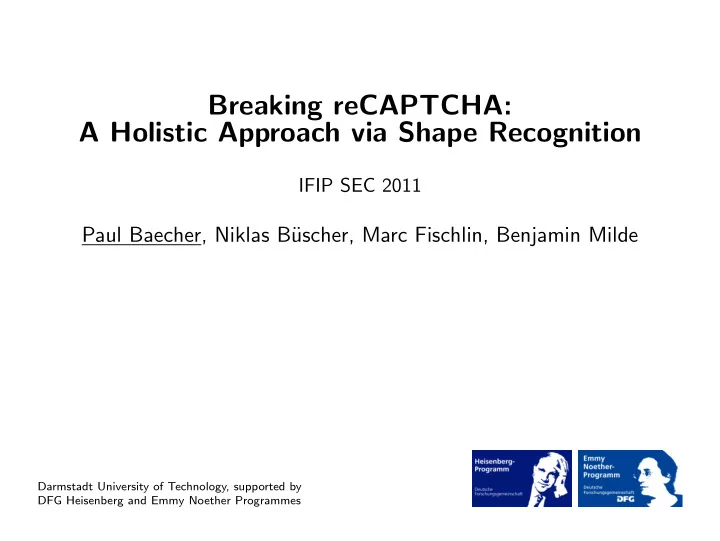

Breaking reCAPTCHA: A Holistic Approach via Shape Recognition IFIP SEC 2011 Paul Baecher, Niklas B¨ uscher, Marc Fischlin, Benjamin Milde Darmstadt University of Technology, supported by DFG Heisenberg and Emmy Noether Programmes
Introduction 1
What Are CAPTCHAs? • C ompletely A utomated P ublic T uring test to tell C omputers and H umans A part • “reverse” Turing test, term coined by [vABHL03] • challenge/response protocol where • response should be easy to observe for humans • response should be hard to compute for machines • 0.01% according to [CLSC05, vAMM + 08] • application: protect online services from automated use image: cryptographp 2
reCAPTCHA 1st generation 2nd generation 3rd generation 4th generation • Very popular CAPTCHA service by Google • may be considered quite “strong” • unique feature: uses OCR source to generate challenges • scan and verification word • dictionary words. . . 3
reCAPTCHA Today reCAPTCHA as of June 2011 (5th generation) 4
Breaking reCAPTCHA 5
Breaking reCAPTCHA – Approach • Typical approach to break text CAPTCHAs • segment into individual letters/digits • recognize each letter/digit individually 6
Breaking reCAPTCHA – Approach • Typical approach to break text CAPTCHAs • segment into individual letters/digits • recognize each letter/digit individually • non-trivial segmentation is considered hard [CLSC05] • our approach • match entire words at once (holistically) • i.e. skip segmentation and treat words as letters 6
High-level Overview (no ellipse) detect edges remove ellipse shape repr. scale 200% • Third generation reCAPTCHA challenges add inverted ellipses 7
Removing the ellipse 1. Approximate ellipse center original challenge 8
Removing the ellipse 1. Approximate ellipse center after erosion operations 8
Removing the ellipse 1. Approximate ellipse center after dilation operations 8
Removing the ellipse 1. Approximate ellipse center center approximated 8
Removing the ellipse 1. Approximate ellipse center 2. run edge detection on the challenge image edge detection 8
Removing the ellipse 1. Approximate ellipse center 2. run edge detection on the challenge image 3. use machine learning to classify contour pixels after classification, 1 round 8
Removing the ellipse 1. Approximate ellipse center 2. run edge detection on the challenge image 3. use machine learning to classify contour pixels after classification, 4 rounds 8
Removing the ellipse 1. Approximate ellipse center 2. run edge detection on the challenge image 3. use machine learning to classify contour pixels after classification, 9 rounds 8
Matching Shapes • Contour line (without ellipse) describes the shape of a word • reCAPTCHA words are dictionary words • key idea: prepare a database of all dictionary words and use common shape matching techniques 9
Matching Shapes • Contour line (without ellipse) describes the shape of a word • reCAPTCHA words are dictionary words • key idea: prepare a database of all dictionary words and use common shape matching techniques • How to build a database of all dictionary words? • How to “match” two shapes? 9
Shape Recognition 10
Shape Recognition • Well-studied problem in Computer Vision • powerful technique: Shape Contexts (SC) • invariant against translation and scaling • compact description of the shape challenge shape reference shapes create SC create SC challenge SC reference SCs match 11
From Shapes to Shape Contexts • Convert shape (set of points in polar space) into SC (sets of two dimensional histograms) • example for one point: angle bins distance bins • use a χ 2 -distance to match sets of histograms 12
Matching Shape Contexts Efficiently • Naive approach is prohibitively slow for 20K dictionary words • more efficient strategy needed • work on a random subset of the sets of points of the shape • start with a small subset and double it gradually • results in logarithmic search space reduction • first/last character special treatment • easy to detect, allows to prune large chunks 13
Experimental Results 14
Results reCAPTCHA generation 2 3 4 Test set size 496 1005 301 Total success rate 12.7% 5.9% 11.6% Run time 24.5s 17.5s 15.4s Dictionary success rate 22% 10.43% 23.5% First character detected 90.2% 73.2% 84.6% • Recall that a CAPTCHA is considered broken at 0 . 01% • performance measurement on verification words only 15
The End Thank you! ? 16
References Kumar Chellapilla, Kevin Larson, Patrice Y. Simard, and Mary Czerwinski. Building segmentation based human-friendly human interaction proofs (HIPs). In HIP , volume 3517 of Lecture Notes in Computer Science , pages 1–26. Springer-Verlag, 2005. Luis von Ahn, Manuel Blum, Nicholas J. Hopper, and John Langford. CAPTCHA: Using hard AI problems for security. In Eli Biham, editor, Advances in Cryptology – EUROCRYPT 2003 , volume 2656 of Lecture Notes in Computer Science , pages 294–311, Warsaw, Poland, May 4–8, 2003. Springer, Berlin, Germany. Luis von Ahn, Benjamin Maurer, Colin McMillen, David Abraham, and Manuel Blum. reCAPTCHA: Human-based character recognition via web security measures. Science , 321(5895):1465–1468, 2008. 17
Recommend
More recommend